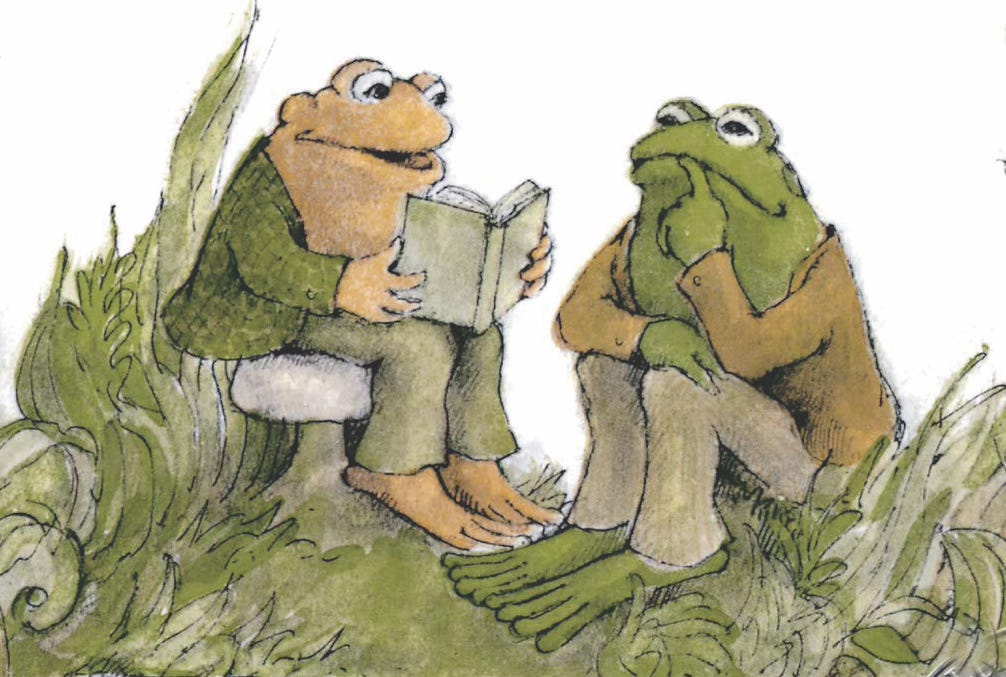The Gentle Wisdom Of Frog & Toad
“Always be on the lookout for the presence of wonder.” E.B White
As a child, some of my favorite and most treasured gifts were books. I loved them so much that I kept the ones that were beloved to me, those cherished classics that were nearest and dearest to my heart. They ranged from Where the Wild Things Are to my box set of The Chronicles of Narnia. I must have been around three of four years old when I received the Frog and Toad series. The first one I got was Frog and Toad Are Friends (published in 1970) followed by Frog and Toad Together (1972), Frog and Toad Year Round (1976) and, lastly, Days With Frog and Toad (1979).
After all these years, why do I still return to these seemingly simple works for beginning readers?
Arnold Label was an awkward and sensitive child. Often bullied at school, Lobel sought refuge in his local library and his imagination. Perhaps that is part of why is most well-known works are known for their gentleness. He once said that picture books were “capable of suggesting everything that is good about feeling well and having positive thoughts about being alive.”
Unlike many authors, Lobel loved creating books only for children. He said, “I cannot think of any work that could be more agreeable and fun than making books for children.” He even described his job as being a “daydreamer.”
With his Frog and Toad series, Arnold Lobel decided he wasn’t going to write for kids but was going to write something he would want to read. The series was inspired by family vacations on Lake Bomoseen, Vermont, where Lobel’s children caught frogs and toads and other small animals. He also chose animal characters because of their relatability. He once said, “By using animals, by pulling it away from everybody, everything, you bring it to everybody. I mean, Frog and Toad belong to no one but they belong to everyone, every sector: rich children, poor children, white children, black children.” By choosing animals, they could also act somewhere between both childhood and adulthood. “You can give animals the freedom of adults,” Lobel said, “while they still maintain the attitudes of children.”
Growing up, Arnold Lobel used his animal drawings as a way of coping with the social insecurity and to make friends.
Frog and Toad were friends but were opposites in personalities and nature. They were inspired by comedy duos like Bob Hope and Bing Crosby, Abbott and Costello. Frog is tall and cheery in personality, while Toad is short, serious and anxiety-ridden. For Lobel, both characters represented aspects of his own personality. As Bert Clere wrote a piece in The Atlantic about Frog and Toad, “Their friendship demonstrates the many ups and downs of human attachment, touching on deep truths about life, philosophy, and human nature in the process.”
Unlike most brightly illustrated children’s books, Lobel used muted colors: browns and greens. His intent was to give the illustrations a cozy, nostalgic feeling. He stated he wanted these books to create a “sense of wellbeing for kids” and of “protection” from the harsh, cruelties of the world.
He strove to create a simpler world for Frog and Toad. Lobel stated, “I’m very careful in the stories not to make allusions to modern life. That’s something I just sense not to do. Frog and Toad don’t call each other on the telephone. Toad takes a walk and he visits Frog. He could, I suppose, pick up the telephone and call, but that would be too much, the world would be too much with them.”
Keep reading with a 7-day free trial
Subscribe to Begin In Wonder Substack to keep reading this post and get 7 days of free access to the full post archives.




